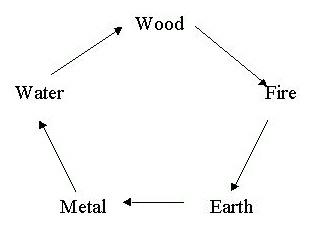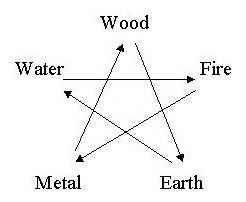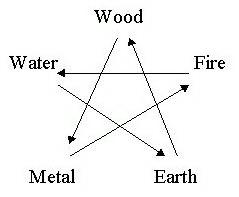Students of Internal Arts can develop quite happily without knowing anything about the Theory of Five Elements. However, this theory is quite ubiquitous in Chinese thought and crops up in most unlikely places. For instance, it is one of the pillars on which Traditional Chinese Medicine was built. It was also used to provide theoretical framework for a number of Chinese martial arts. In particular it is most closely interwoven into Xingyiquan. As most of the articles to date have referred mainly to Taijiquan, I thought it was time to redress the balance and include something for my Baguazhang/Xingyiquan students. The Theory of Five Elements seems most suitable and it would also be of interest to Taijiquan and Qigong students.
The name Five Elements is misleading as it suggests association with static, immutable properties. Occasionally an attempt is made to find a better translation and so far I've seen Five Phases and Five Elementals. The last one, I am told, is the most accurate so far but as the name Five Elements is the one almost universally adopted, I'll use that one.
The Five Elements in question are abstract entities represented in nature by Metal, Water, Wood, Fire and Earth and are used to classify all known phenomena by how closely their properties match those of these Five Elements. Having classified things by their properties, the Theory is then used to explain and chart their relationships and mutual interaction.
The following table shows some typical categories:
Element | Direction | Weather | Five Yin organs | Feelings | Five Yang organs | Colours | Tastes |
|---|---|---|---|---|---|---|---|
Wood | East | Wind | Liver | Anger | Gall Bladder | Green | Sour |
Fire | South | Hot | Heart | Joy | Small Intestine | Red | Bitter |
Earth | Centre | Humid | Spleen | Meditate | Stomach | Yellow | Sweet |
Metal | West | Dry | Lung | Worry | Large Intestine | White | Pungent |
Water | North | Cold | Kidney | Fear | Urinary Bladder | Black | Salty |
There are three cycles which describe the mutual interaction of the five elements. They are Creative Cycle, Destructive Cycle and Counter-active Cycle. Sometimes you may come across different description but the relationships are always the same.
Creative Cycle:
This cycle describes the interaction of the Five Elements where one Element promotes the next one.
We water plants (wood) to make them grow, so we say Water gives rise to or is mother of or promotes Wood. Wood burns easily so Wood gives rise to Fire. When you burn things, you are left with ashes which we can take as representation of Earth, so Fire gives rise to Earth. Metals are mined underground, i.e. Earth gives rise to Metal. If you heat Metal, it melts into a liquid form; being liquid is a property of water so Metal gives rise to Water.
Expressed in a diagram:

Each Element is said to be a Mother of the Element following it, and a Son of the one preceding it. Thus Wood is the Mother of Fire and Fire is the Son of Wood, etc.
The problem with this cycle is that the Elements would keep on growing indefinitely. We need some mechanism for controlling such unchecked growth. The next cycle, the Destructive cycle, provides just such a control.
Destructive Cycle:
This cycle is the opposite of the Creative Cycle in that it expresses relationship where one Element exerts control, suppresses or inhibits another Element.
Plants deplete earth as they extract nutrients and even the hardest rock will eventually crack when soft plants take root. Thus Wood destroys Earth. An axe, being made of metal, can split wood. Thus Metal destroys Wood. Fire can melt metal, thus Fire destroys Metal. Water can be used to douse fire, thus Water destroys Fire. And finally, flow of water can be stopped by earth, thus Earth destroys Water.
Expressed in a diagram:

The words destructive and destroy are used as a counterpoint to the creative cycle earlier. In practice the relationship is more of control or influence. For example the banks of a river control the flow of the water, inhibiting water's natural property of flowing freely in all directions.
These two cycles provide a balance necessary for normal growth and development. The next cycle expresses 'pathological' conditions which arise when the balance is disturbed.
Counter-acting Cycle:
Sometimes the acted-upon Element is too strong, or the acting Element too weak and the 'natural' order is temporarily reversed. Continuing with the above examples, if a fire is too big and fierce or there is not enough water, the fire is not extinguished but rather the water is vaporized. If the river swells, it may burst its banks or destroy the dam which bars its way, etc.
Expressed in a diagram:

Five Elements and Xingyiquan
As I have mentioned above, the Theory of Five Elements is used as a philosophical foundation of some of the Chinese martial arts and in particular that of Xingyiquan.
The basis of Xingyiquan is Wuxingquan which can be translated as Five Element Boxing. It contains five techniques or fists (quan) each of which is associated with one of the Elements.
The first technique is Piquan, translated as Splitting or Cutting Fist, and is associated with Metal. It is used as a wedge with which to 'split' and deflect opponent's attack while simultaneously attacking. The mental image the practitioners concentrate on is that of an axe splitting a log.
The second fist (following the Creative cycle) is Tzuanquan, Drilling Fist, which is associated with Water. The image is that of water suddenly bursting through the dam and sweeping all in its path.
The third one is Pengquan, Crushing Fist, and it is associated with Wood. The image is that of an arrow hitting it's target.
The fourth one is Paoquan, Cannon Fist, associated with Fire. The image is that of a flame suddenly leaping out or a bullet leaving a barrel of a gun
The fifth one is Hernquan, Crossing Fist, associated with Earth. The image is that of a large rock rolling down a mountain.
The above images are just few examples. Each practitioner should strive to understand and express through his/her movements the quality of each of the Elements. It is often the case that the qualities of the 'Elements' change as the students develop and deepen their understanding.
The Creative, Destructive and Counter-active cycles described above are then used in understanding how to apply each technique, how to transform one technique into another and how to counter one technique with another. There are various drills and two man sparring sets which are used to give students the initial 'feel' for these relationships.
At a more advanced stage there is the Twelve Animals system which combines the Five Elements into a richer tapestry of moves and mental attitudes. Different schools of Xinqyiquan have slight variations in the selection of the animals. We study the following styles:-
Horse, Tiger, Dragon, Swallow, Snake, Bear and Eagle, Chicken, Hawk, Kingfisher, Crocodile, and Monkey.
In the same way as the Five Elements are not representing real elements but rather act as symbols for certain qualities, each animal style consists of moves which try to capture the essential spirit of the animal, rather than mimic its moves.